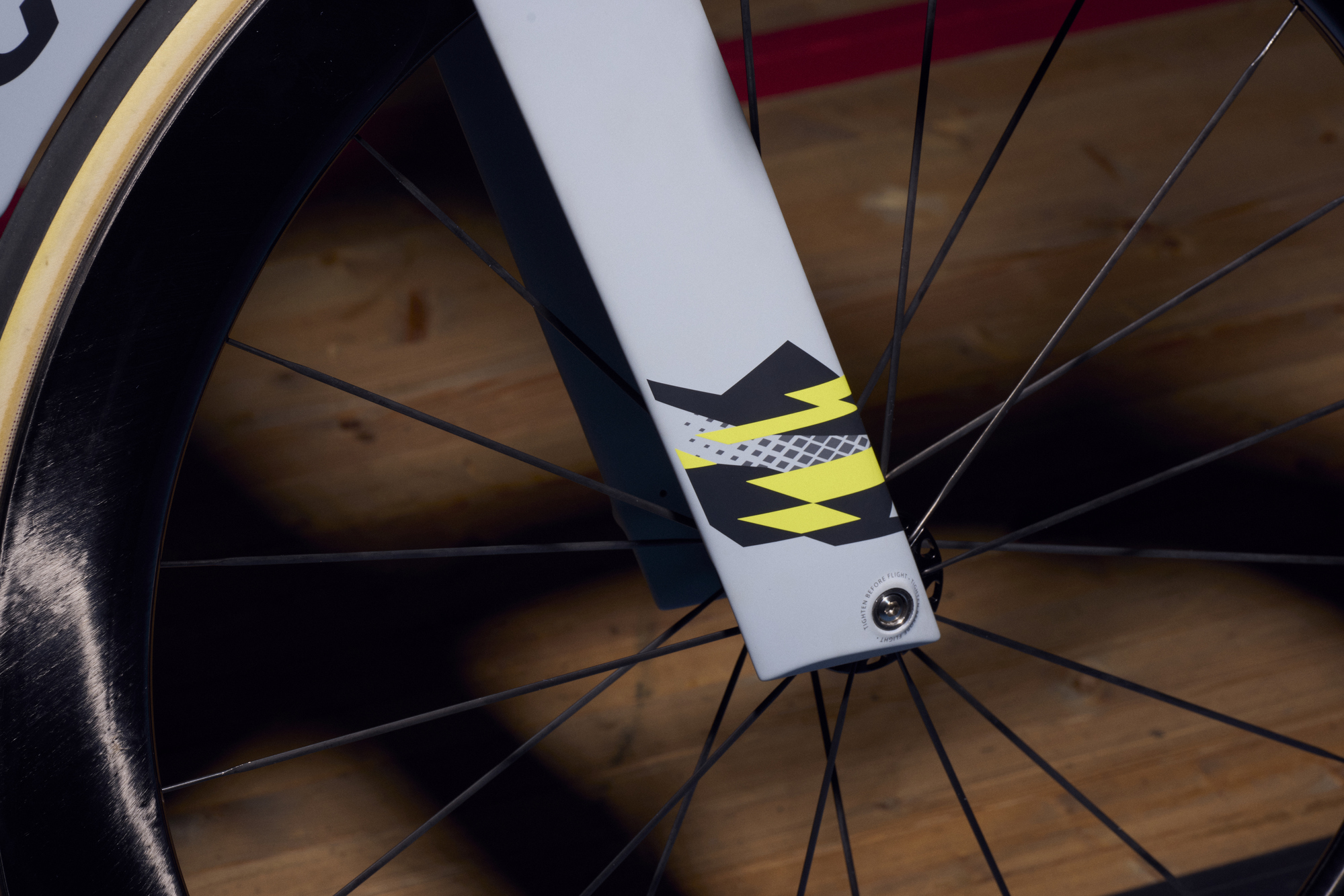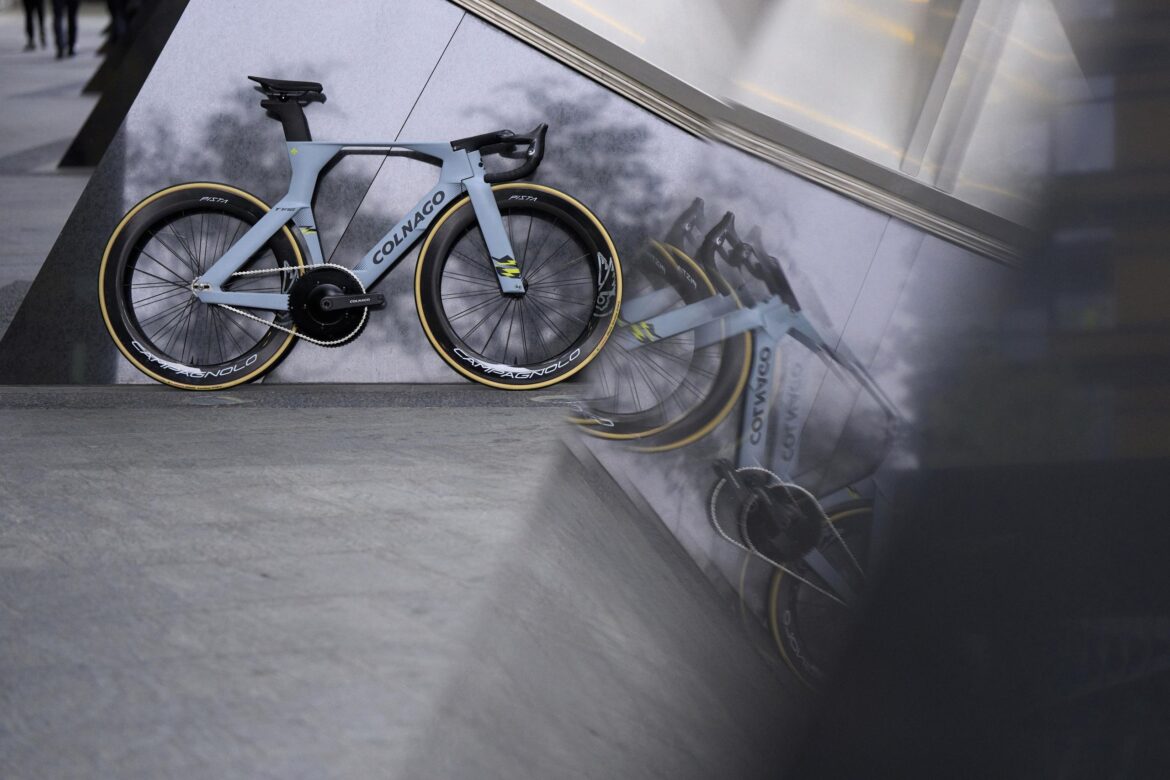The new Colnago T1Rs is here. The Italian brand’s new track frame claims to be more aerodynamic, stiffer, versatile, and feature a geometry that makes it suitable for bunch races, individual events, and sprinting.
Its the first dedicated Colnago track bike since the K-One, which was last used in around 2018; the Italian brand does not currently supply a big nation with their velodrome machines.
A whole new aero design, for a whole new challenge
So why did Colnago even need the new frame? The last few years have seen aerodynamics drastically increase the speed of bike racing. The team pursuit world record now sits at 3:40.730, while the individual pursuit has dipped below 4 minutes, previously a winning time for the team event.
Meanwhile, bunch events are also raced at speeds in excess of 60kph, and this requires a new design process to create the fastest track frame for the job.
Aerodynamics are not linear
Why does speed matter? Weight is a simple metric because the factors it affects respond more linearly. Since gravity remains constant, reducing weight results in a linear performance gain when air resistance stays steady. However, aerodynamics differ because air resistance increases proportional to the square of velocity, while the power needed to overcome it rises cubically.
In other words, the faster you go, the more challenging the problem becomes. At higher speeds, the power required to overcome drag is much greater than at lower speeds, and it is this physics that explains why, at the Tour de France this year, the fastest setup for the top GC contenders in the mountain TT was a time trial bike rather than a road bike, even when 1kg lighter. That’s how quickly the pros were climbing those mountains.
At track racing speeds, the speeds are even higher, so air resistance is the most dominant force a rider experiences, above all other factors. If I have my maths correct, at 60kph on a 0˚ gradient, the percentage of the force you have to produce to overcome aerodynamic drag is ~94.5%, increasing to 95.9% at 70kph.
This is why the new T1Rs has been designed with speeds of above 60 kph in mind, specifically for these racing speeds. And that specificity is very important.
Why not just copy an aero bike?
Different frame structures perform aerodynamically in different ways at various speeds. One bike might be faster than another at 30 kph, but that relationship could reverse at 60 kph.
One of the main reasons for this is the Reynolds number (Re). Lower Re generally promotes smoother, more laminar airflow, while higher Re produces a more energetic, turbulent boundary layer. Because Re increases proportionally with velocity (when altitude and air density are constant), the faster the speed, the higher the Re.
As speed increases, the air behaves in a more turbulent yet higher-energy manner, which has significant aerodynamic consequences. We see examples of this optimisation elsewhere. For instance, many cycling garments and components incorporate small surface “trips” — textures or seams on front-facing cylindrical surfaces such as the arms — to induce controlled turbulence. This helps the airflow stay attached longer, reducing pressure drag behind the body and lowering total drag, even though skin-friction drag rises slightly. At higher speeds, where air naturally tends toward turbulence, this strategy generally requires the trips to be spaced closer together to adapt to the increased speed.
For frames, the situation differs slightly. Tube sections can be designed as airfoil-like shapes rather than cylindrical ones and feature a longer chord length (the straight line distance from leading to trailing edge). Evidence of this can be seen in the design of the TR1S fork, which exhibits longer, ‘flatter’ aerofoil shapes and an extended chord length. This is because, in this context, aerodynamic efficiency depends heavily on the airflow remaining attached along the surface. The longer the chord or surface, the longer air flows cleanly over it. On the track, where handling and weight are less constrained than on the road, deeper and longer airfoil profiles can be utilised without compromise. At the higher Reynolds numbers reached at 60–70 kph, the airflow has enough energy to stay attached over a long, tapered section. This results in less flow separation, smaller wakes, and consequently lower pressure drag.
A closer look at the design reveals that these differences are more noticeable with the Y1Rs. The new T1Rs frame leverages this by using elongated profiles that taper to fine trailing edges. Although this slightly increases surface area and skin-friction drag, the significant reduction in pressure drag leads to an overall lower drag coefficient.
By contrast, Kamm-tailed tube shapes, characterised by a truncated, squared-off rear, are more common on road frames because they perform effectively across a wide range of yaw angles, such as those encountered in crosswinds and at lower speeds. However, at higher speeds, the effective yaw angle decreases; the apparent wind approaches more directly head-on, allowing shapes to be optimised for that scenario.
On an indoor track, yaw angles are minimal, so the benefits of the truncated profile largely become negligible. Under these conditions, longer, sharper, and pointed airfoil tubes, like those on the T1Rs, generally deliver superior aerodynamic performance.
Interestingly, at lower speeds and lower Re, the less energetic air with greater potential for separation may not stay attached to the length of the tube shape as well, resulting in increased pressure drag from similar designs. What works well in one situation may perform poorly in another.
(Image credit: Colnago)
You wouldn’t expect to drive an F1 car through a town centre
Why don’t we see this design methodology on road bikes and time trial bikes?
It’s not entirely accurate to say we don’t see it at all. Of course, some elements of this are present on TT bikes, given the 50-55kph average speeds that pros ride at during those events. However, on road bikes and TT bikes, external factors mean these frame shapes would not be suitable.
First, crosswinds. Not only would this T1Rs frame be more difficult to handle in windy conditions, but the shape of the tubes could also hinder performance compared to the more tailed profile of the Y1Rs. Next is weight; these tube shapes are heavier because more material is needed to create them.
Stiffness is another consideration. On the road, the tarmac is far less smooth than a velodrome’s wooden surface. Extended tube shapes tend to offer poor compliance, making a bike like the T1Rs extremely unforgiving outside a velodrome.
Finally, practical considerations come into play, such as water bottles. In a race on the road, you need to carry water. The T1Rs isn’t intended to solve this problem, and owing to its design, it’s highly likely that attaching a bottle would slow the bike down.
This issue is addressed very specifically in Colnago’s TT1 frame, with its integrated frame bottles, and similarly, the Y1Rs’s integrated bottle cage, which shields a standard bottle and integrates it into the frame, designed for specific operating conditions.
What the T1Rs represents is akin to a F1 car — designed for speed and racing on a track. Adding gears, brakes, or bottle cages would undoubtedly prevent it from becoming a fast, or even decent, road bike.
Design studies leading to bikes like this exemplify the application of specificity—creating shapes that perform optimally within their intended environment, much like a fighter jet or a Formula 1 car. Outside that context, it would likely be much slower.
That’s what makes bikes like this really exciting.

(Image credit: Colnago)
Explore More
